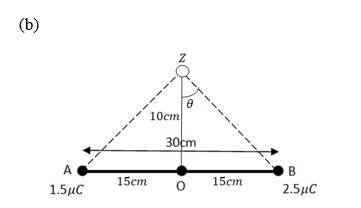Potential Energy of a System of Charges: The potential energy of a system of charges in an NCERT Class 12 Physics context typically relates to the electrostatic potential energy associated with these charges. This potential energy is a measure of the energy stored within a system of charged particles due to their mutual interactions. It is calculated using Coulomb's law, which describes the electrostatic force between point charges.
Potential Energy Formula
The formula for the potential energy (U) of a system of charges is as follows:
U = k (q1 q2) / r
Where:
U is the potential energy.
k is Coulomb's constant, approximately equal to 9 x 109 N·m2/C2 in SI units.
q1 and q2 are the magnitudes of the charges of the two point charges in the system.
r is the distance between the charges.
The potential energy is a measure of the work done in assembling the system of charges from infinity (where the potential energy is defined as zero) to their current positions. When like charges (q1 and q2 with the same sign) are brought closer together, the potential energy becomes more positive, indicating that energy has been added to the system. On the other hand, when opposite charges (q1 and q2 with different signs) are brought closer together, the potential energy becomes more negative, indicating that work has been done to separate them.
In summary, in Class 12 physics, the potential energy of a system of charges is a measure of the energy associated with their electrostatic interactions, and it depends on the magnitudes of the charges and the distance between them. This concept is important in understanding the behaviour of electric fields, electric potential, and the principles of electrostatics.
FAQs on Potential Energy of a System of Charges
Q. A charge of 8 mC is located at the origin. Calculate the work done in taking a small charge of –2 × 10–9 C from a point P (0, 0, 3 cm) to a point Q (0, 4 cm, 0), via a point R (0, 6 cm, 9 cm).
A . Charge located at the origin O, q=8 mC= 8 C
Magnitude of a small charge, which is taken from point P to Q, = -2 C
Pont P is at a distance, = 3 cm = 0.03 m from origin, along Z axis
Point Q is at a distance, = 4 cm = 0.04 m from origin, along y axis
Potential at point P, =
Potential at point Q, =
= permittivity of free space = 8.854
Work done, W = = =
= (-0.1438) = 1.198 J
Q. A cube of side b has a charge q at each of its vertices. Determine the potential and electric field due to this charge array at the centre of the cube.
A. Length of the side of a cube = b
Charge at each vertices= q
d = diagonal of each face, d = = b
l = length of the solid diagonal, l = = b
If r is the distance from the centre of the cube to its corner, then r = l/2 =
The electric potential (V) at the centre of the cube is due to the presence of eight charges at the vertices.
V = = =
Therefore, the potential at the centre of the cube is
The electric field at the centre of the cube, due to eight charges, gets cancelled, since the charges are distributed symmetrically. The electric field is zero at the centre.
Q. Two tiny spheres carrying charges 1.5 μC and 2.5 μC are located 30 cm apart. Find the potential and electric field: (a) at the mid-point of the line joining the two charges, and (b) at a point 10 cm from this midpoint in a plane normal to the line and passing through the mid-point.
A. Two charges are at point A and B. O is the midpoint of line joining A & B
Magnitude of charge at point A, = 1.5 = 1.5 and
at point B, = 2.5
Distance between A & B, d = 30 cm = 0.3 m
- Let and be the electric potential and electric field respectively at O.
Potential due to charge at A + Potential due to charge at B
+ = (
= permittivity of free space = 8.854
(1.5 = 2.4 V
Electric field due to - Electric field due to
=
= 4.0 V/m
Therefore, the potential at mid-point is 2.4 V and the electric field is
4.0 V/m and it is directed from larger charge to smaller charge.


Q.2.15
News & Updates
Physics Electromagnetic Induction Exam
Student Forum
Popular Courses After 12th
Exams: BHU UET | KUK Entrance Exam | JMI Entrance Exam
Bachelor of Design in Animation (BDes)
Exams: UCEED | NIFT Entrance Exam | NID Entrance Exam
BA LLB (Bachelor of Arts + Bachelor of Laws)
Exams: CLAT | AILET | LSAT India
Bachelor of Journalism & Mass Communication (BJMC)
Exams: LUACMAT | SRMHCAT | GD Goenka Test
